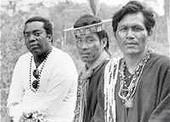TXAI

"I heard the echo of my own voice in the woods. Not just the repetition; the sound follows the river's path
Before, I was afraid people wouldn't believe what I have to tell. I'm not afraid like that anymore.
When you lean against a slope, in that procession of canoes - that's when you truly find Brazil.
TXAI is the half of me that exists in you, the half of you that is in me.
TXAI is more than brother, more than friend.
It is time to tell others this."
Milton Nascimento
MILTON NASCIMENTO AT THE JURUÁ
By invite of the National Counsil of Tappers (CNS in Brazil) and the Indigenous United Nations (UNIS in Brazil), Milton Nascimento sailed for seventeen days the crystal clear waters of the High Juruá and the Amônea river, in the extreme west of Acre, border of Brazil and Peru last August.
He exchanged this usual baseball cap for a straw hat and "came to see up close to know for sure" the reality of the woodland folk, whose alliance made in Rio Branco during the First Meeting of indigenous people and tappers in March 1989 (look for the final statement in the Amazônia chart/document at the end of this magazine) had been announced to the "cityfolk" at one of his concerts last May in São Paulo. The trip through Juruá all the way to the Campa das Cabeceiras do Amônea tribes was organized and documented by the staffs of the CEDI and the Quilombo Produções, in collaboration with UNI, CPI-Acre, CNs and the Associação dos Seringueiros do Rio Tejo.
Macedo was the master. Terri and Mauro Almeida, acreano anthropologists guided the findings, registered by the cameras of Siá Kxinawa, Charles Vincent (video) and Márcio Ferreria (photos). Rubens Matuck, plastic artist, took the pictures of the people and nature.
The Associação dos Seringueiros's boat didn't make it through Gastão's waterfall, close to Vila Taumaturgo. Summertime, low waters and risen sand banks. Though driven by specialists in river sailing, like Zé das Águas, the boat struck land dozens of times.
Nights spent on the beaches, in riverfolk's houses, talking about whatever was new in a day-to-day life marked by the abundance of grazed meadows of mandi piracemas and the joy of the Campa families, spending their summers in tapiro at beaches, drinking caissuma, or making cusmas of cotton and singing folk songs in the mirages of huasca weeds. Pink river dolphin played in the morning vapors of the warm waters.
Stories of tappers not abiding by orders, of the hard life in the extractivist reservation's project's forest of Tejo river, the moving from Campo de Peru to Brazil, fleeing the mandatory military service that the Peruvian army tries to impose on some villages to combat Sendero Luminoso.
Milton spoke little, but noticed all with a lot of attention. He was given fruits and fish as gifts from the riverfolk, "like a famous singer", announced by the Forest Radio but not always recognized by name. He took advantage of this semi-anonymity to sing songs by other songwriters, always accompanied by improvised bands with the participation of local musicians. At the end of the journey, this was considered, by both Milton and the other members of the camp as a remarkable experience which will bring good material to the record and shows he should be doing the following year to support the "Alliance of the Woodland Folk".
ISA - Social-environmental Institute
Isa is a civil Brazilian association which emerged from the transformation and fusion of renowned institutions (CEDI and NDI), founded in 1994 by people with graduation and experience in the fight for the social rights and environmental rights.
ISA understands social and environmental issues, as integrated, and takes action to the conservation, sustainable use and repartition of benefits derived from biodiversity, seeking the respect to collective and diffused rights and the enhancing of the population's life quality.
ISA also acts in the mobilization and awareness of the society to change the social and environmental degradation situation of the country, acting through political, juridical actions, production and distribution of information and developing leading projects that can be disseminated and multiplied.
ISA develops programs, projects and campaigns of local, regional, national and international reach, in which the priority subjects are indigenous peoples, quilombo reminiscent as well as other traditional populations, conservation units, natural resources, cultural heritage, human and peoples' rights, citizenship and biodiversity.
ISA acts countrywide and specially in the High Black River(Amazonas), Indigenous Xingu Park (Mato Grosso), the Valley of the Ribeira and São Paulo's metropolitan region.
An important parto of ISA's work is done by the GIS lab, whose maps allow the systematic monitoring of public policies in the socio-environmental theme.
